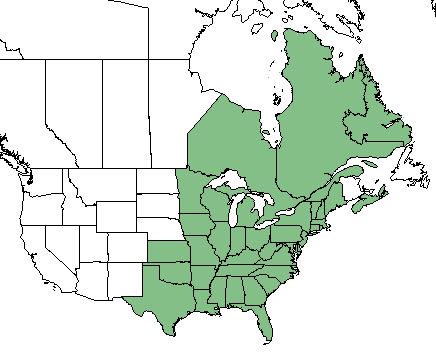Difference between revisions of "Sisyrinchium angustifolium"
(→Ecology) |
(→Ecology) |
||
| Line 30: | Line 30: | ||
==Ecology== | ==Ecology== | ||
| − | ===Habitat=== <!--Natural communities, human disturbed habitats, topography, hydrology, soils, light, fire regime requirements for removal of competition, etc.--> | + | ===Habitat=== |
| + | Typical habitats for this grass include woodlands, forests, meadows, and sandhill swales. <ref name= "Weakley"> Weakley, A. S. (2015). Flora of the Southern and Mid-Atlantic States. Chapel Hill, NC, University of North Carolina Herbarium.</ref> | ||
| + | |||
| + | Soils with a medium to fine texture is more hospitable to ''S. angustifolium''. <ref name= "USDA"> [https://plants.usda.gov/core/profile?symbol=CEAM USDA Plant Database]</ref> | ||
| + | |||
| + | The grass has a intermediate tolerance for shade and a low tolerance for shade. <ref name= "USDA"> [https://plants.usda.gov/core/profile?symbol=CEAM USDA Plant Database]</ref> | ||
| + | <!--Natural communities, human disturbed habitats, topography, hydrology, soils, light, fire regime requirements for removal of competition, etc.--> | ||
===Phenology=== | ===Phenology=== | ||
''S. angustifolium'' flowers between January and May, largley producing blooms in March and April. <ref name= "Pan Flora"> [http://www.gilnelson.com/PanFlora/ Pan Flora]</ref> | ''S. angustifolium'' flowers between January and May, largley producing blooms in March and April. <ref name= "Pan Flora"> [http://www.gilnelson.com/PanFlora/ Pan Flora]</ref> | ||
| Line 36: | Line 42: | ||
<!--===Seed dispersal===--> | <!--===Seed dispersal===--> | ||
<!--===Seed bank and germination===--> | <!--===Seed bank and germination===--> | ||
| − | + | ===Fire ecology=== | |
| + | The grass has a high tolerance for fire. <ref name= "USDA"> [https://plants.usda.gov/core/profile?symbol=CEAM USDA Plant Database]</ref> | ||
| + | <!--Fire tolerance, fire dependence, adaptive fire responses--> | ||
<!--===Pollination===--> | <!--===Pollination===--> | ||
<!--===Use by animals===--> <!--Herbivory, granivory, insect hosting, etc.--> | <!--===Use by animals===--> <!--Herbivory, granivory, insect hosting, etc.--> | ||
Revision as of 19:09, 29 May 2018
| Sisyrinchium angustifolium | |
|---|---|

| |
| Photo by John Hilty hosted at IllinoisWildflowers.info | |
| Scientific classification | |
| Kingdom: | Plantae |
| Division: | Magnoliophyta - Flowering plants |
| Class: | Liliopsida - Moncots |
| Order: | Liliales |
| Family: | Iridaceae |
| Genus: | Sisyrinchium |
| Species: | S. angustifolium |
| Binomial name | |
| Sisyrinchium angustifolium Mill. | |

| |
| Natural range of Sisyrinchium angustifolium from USDA NRCS Plants Database. | |
Contents
Taxonomic Notes
Synonym: S. graminoides (E.P. Bicknell)
Variety: none
Description
S. angustifolium is a perennial forb/herb of the Iridaceae family that is native to North America. [1]
Distribution
S. angustifolium is found throughout the eastern North American Continent, as far west as Texas, Kansas, and Ontario, Canada. [1]
Ecology
Habitat
Typical habitats for this grass include woodlands, forests, meadows, and sandhill swales. [2]
Soils with a medium to fine texture is more hospitable to S. angustifolium. [1]
The grass has a intermediate tolerance for shade and a low tolerance for shade. [1]
Phenology
S. angustifolium flowers between January and May, largley producing blooms in March and April. [3]
Fire ecology
The grass has a high tolerance for fire. [1]